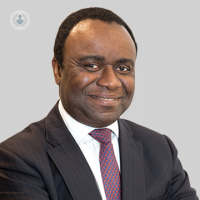Magnetic growing rods: exciting advances in the treatment of early onset scoliosis
Written by:As young children grow, it’s normal that development of the spine varies case by case, and small curves are nothing to worry about – they are a regular part of the spine’s anatomy. However, not all cases are meaningless. While early onset scoliosis (EOS) is rare, it can develop any time between birth and the age of ten, so it is important to watch your child and check for the symptoms of the condition: leaning to one side, the spine becoming more apparent, and an uneven waist or uneven hips.
If symptoms like this present, and early onset scoliosis is a possibility, your child may be referred on to specialist surgeon like Mr Colin Nnadi. Here, he explains the latest developments in spinal surgery, and how they can benefit children diagnosed with EOS.

What is the traditional treatment for early onset scoliosis
Early onset scoliosis involves the development of a spinal curvature between birth and the age of ten. If untreated, EOS can have profound consequences on cardiorespiratory function and life expectancy.
In the UK, growing rods have been one of the typical treatment methods used. In this type of surgery, one or two rods are inserted under the skin, which span the curve and correct it over time. Their main drawback, however, is the need for repeated operations to lengthen the rod – these operations are usually performed every six months. Surgery may also be combined with other traditional treatments, such as a cast or brace fitted to the child.
However, new methods and approaches in the treatment of early onset scoliosis are being introduced, providing young patients and their families with new opportunities and different treatment paths. One such treatment is the use of magnetically controlled growth rods.
How are controlled growth rods used in the treatment of early onset scoliosis?
Non-invasive lengthening in the form of magnetically controlled growth rods was first introduced to the United Kingdom in 2009. The magnetic rod system makes use of sterile, single-use, implantable rods, along with an external remote controller.
Rather than having repeated surgical procedures performed, the rods are lengthened periodically through using a magnetic mechanism that converts rotational forces into axial distraction forces, which are used to both brace the spine during growth and prevent progression of the scoliosis.
How can magnetically controlled growth rods benefit the patient?
Magnetically controlled rods are an alternative solution to traditional growing rods, allowing support of the spine while controlling curve progression. Repeat surgery can be strenuous for both the child and the family, with the child frequently undergoing surgical procedures, sometimes as often as every six months. While the surgery is not complex and adjusts the rods and screws, it does need the child to go through rehabilitation, reduces activity levels, and carries a risk of infection.
Magnetic growth rods minimise the need for surgery – they are first implanted with a surgical procedure, but repeat invasive procedures are rendered unnecessary as the lengthening and shortening of the rods is performed as an outpatient procedure at a specialist clinic. There is no need for any type of surgery and the child can be home the very same day – much like a regular doctor’s appointment. This offers great benefit for families, as the child does not miss out on school time, experience long periods of downtime from regular activities, and does not have to go through periods of rehabilitation.
If you are interested in learning more about magnetic growing rods and how they could help you and your child in the treatment of early onset scoliosis, book an appointment with Mr Colin Nnadi to discuss possibilities.


